文章目录
从Spring2开始引入注解,Spring3已经可以纯注解开发,以避免使用复杂的配置文件
1. IOC/DI注解开发
1.1 Component注解
@Component
- 在对应类上添加Component注解

- 在applicationContext.xml指定要扫描的路径
 注意:这里首先创建了context命名空间,然后使用了
注意:这里首先创建了context命名空间,然后使用了component-scan和base-package,之后就可以正常获取bean了- 扫描的范围是 base-package 指定的范围 - 测试BookService
//BookServiceImpl.java@Component//可以不添加名称,之后按类型获取``````//applicationContext.xml<context:component-scan base-package="org.example"/>``````//App.javaBookService bookService = ctx.getBean(BookService.class);bookService.save();
@Controller @Service @Repository
这三个注解是Component的衍生注解,作用和Component相同,只是为了区分某个类是属于
表现层
、
业务层
还是
数据层
的类

- Controller注解:表现层,例如BooServlet.java
- Service注解:业务层,例如BookServiceImpl.java
- Repository注解:数据层,例如BookDaoImpl.java(代表mybatis里面的mapper部分)
1.2 纯注解开发模式
不再写applicationContext.xml配置文件,而是用Config类替代
- 创建Config类
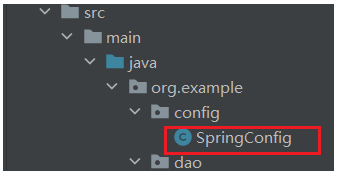
@Configuration//表示这是个配置类,相当于applicationContext.xml默认部分,如命令空间xmlns那一块内容@ComponentScan("org.example.dao")//相当于设置了<bean>标签publicclassSpringConfig{}之前的applicationContext.xml已经可以删除了- @Configuration:设置该类为spring配置类- @ComponentScan:设置spring配置类扫描路径,此注解只能添加一次,多个数据用{}格式,如@ComponentScan({"org.example.dao","org.example.service"}) - BookDaoImpl.java
packageorg.example.dao.impl;@Repository("bookDao")publicclassBookDaoImplimplementsBookDao{publicvoidsave(){System.out.println("book dao save ...");}} - 使用SpringConfig:AnnotationConfigApplicationContext
publicclassAPP{publicstaticvoidmain(String[] args){ApplicationContext ctx =newAnnotationConfigApplicationContext(SpringConfig.class);BookDao bookDao =(BookDao) ctx.getBean("bookDao");System.out.println(bookDao);BookService bookService = ctx.getBean(BookService.class);System.out.println(bookService);}}
1.3 注解开发bean管理
@Scope
设置是否为单例模式

@PostConstruct @PreDestroy
管理生命周期 init() 和 destroy()
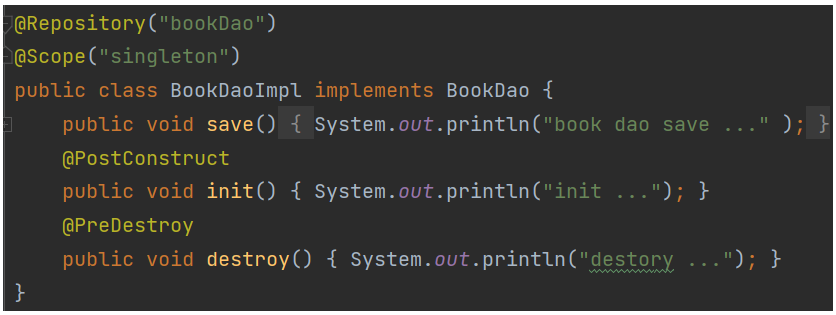
AnnotationConfigApplicationContext ctx =newAnnotationConfigApplicationContext(SpringConfig.class);BookDao bookDao =(BookDao) ctx.getBean("bookDao");System.out.println(bookDao);
ctx.close();//关闭容器,从而可以看到destroy()的信息
1.4 注解开发依赖注入
@Autowired @Qualifier
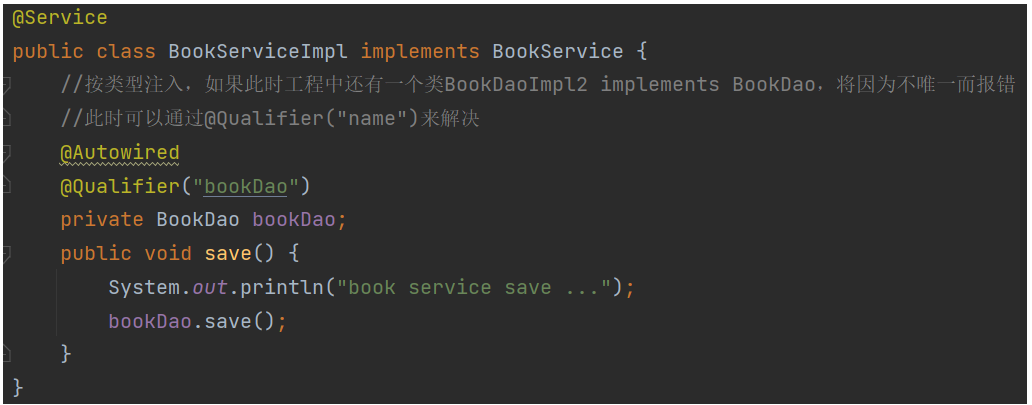
如果只有一个实现类implements BookDao时,仅需@Autowired即可自动注入
如果只有多个实现类implements BookDao时,还需@Qualifier(“name”)指定哪一个实现类
使用@Autowired可以省略setter方法
@Value

name变量被注入了值 “example”
这样单纯使用@Value是没有意义的,注解主要是为了加载properties文件,使得变量值可更改
@PropertySource
读取Properties配置文件
- 新建jdbc.properties
name=example - 配置Config类
packageorg.example.config;@Configuration@ComponentScan({"org.example.dao","org.example.service"})@PropertySource("classpath:jdbc.properties")publicclassSpringConfig{} - 注入
packageorg.example.dao.impl;@Repository("bookDao")publicclassBookDaoImplimplementsBookDao{@Value("${name}")privateString name;publicvoidsave(){System.out.println("book dao save ..."+name);}}
注意事项:(1)多个properties配置文件同样使用{}格式;(2)不支持通配符
1.5 第三方bean管理
@Bean
- 导入依赖
<dependency><groupId>com.alibaba</groupId><artifactId>druid</artifactId><version>1.1.16</version></dependency> - 配置Config文件
@ConfigurationpublicclassSpringConfig{//1. 定义一个方法获得要管理的对象//2. 添加@Bean,表示当前方法的返回值是一个bean@BeanpublicDataSourcedataSource(){DruidDataSource ds =newDruidDataSource(); ds.setDriverClassName("com.mysql.jdbc.Driver"); ds.setUrl("jdbc:mysql://localhost:3306/spring_db"); ds.setUsername("root"); ds.setPassword("root");return ds;}} - 获取Bean并运行
ApplicationContext ctx =newAnnotationConfigApplicationContext(SpringConfig.class);DataSource dataSource = ctx.getBean(DataSource.class);System.out.println(dataSource);
@import(多个Config类)
像是上面的dataSource()这类的通常会专门创建一个Config类,如JdbcConfig,现在需要使其生效
方法一(不推荐)
- JdbcConfig.java
@ConfigurationpublicclassJdbcConfig{@BeanpublicDataSourcedataSource(){DruidDataSource ds =newDruidDataSource(); ds.setDriverClassName("com.mysql.jdbc.Driver"); ds.setUrl("jdbc:mysql://localhost:3306/spring_db"); ds.setUsername("root"); ds.setPassword("root");return ds;}} - 还需要配置SpringConfig.java
@Configuration@ComponentScan("org.example.config")publicclassSpringConfig{}
方法二(推荐)
- JdbcConfig.java
publicclassJdbcConfig{//注意,没再使用@Configuration@BeanpublicDataSourcedataSource(){DruidDataSource ds =newDruidDataSource(); ds.setDriverClassName("com.mysql.jdbc.Driver"); ds.setUrl("jdbc:mysql://localhost:3306/spring_db"); ds.setUsername("root"); ds.setPassword("root");return ds;}} - 配置SpringConfig.java
@Configuration@Import(JdbcConfig.class)publicclassSpringConfig{}
练习:使用@Value和properties文件修改上述代码
引用类型的注入
- BookDaoImpl.java
@RepositorypublicclassBookDaoImplimplementsBookDao{publicvoidsave(){System.out.println("book dao save ...");}} - SpringConfig.java
@Configuration@ComponentScan("org.example.dao")//关联到BookDaoImpl@Import(JdbcConfig.class)publicclassSpringConfig{} - JdbcConfig.java
@PropertySource("classpath:jdbc.properties")publicclassJdbcConfig{@Value("${jdbc.driver}")privateString driver;@Value("${jdbc.url}")privateString url;@Value("${jdbc.username}")privateString username;@Value("${jdbc.password}")privateString password;@BeanpublicDataSourcedataSource(BookDao bookDao){System.out.println(bookDao);DruidDataSource ds =newDruidDataSource(); ds.setDriverClassName(driver); ds.setUrl(url); ds.setUsername(username); ds.setPassword(password);return ds;}} - 自动装配 上面仅提供了一个形参bookDao,即可自动注入 这是因为@Bean使其认为形参应当被自动提供,于是将自动寻找相应的类,并注入到形参中
总结
- 1.第三方Bean管理 - @Bean
- 2.第三方依赖注入 - 引用类型:方法形参- 简单类型:成员变量
1.6 XML配置和注解配置对比
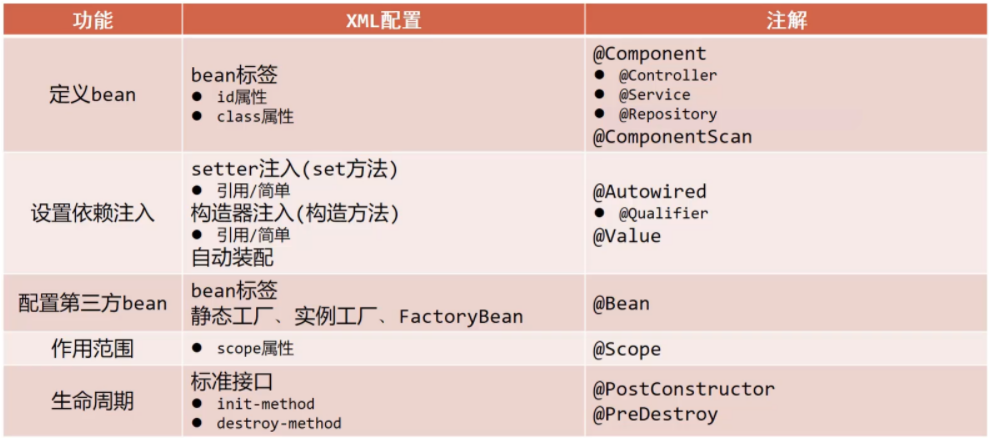
2. Spring整合MyBatis
2.1 mybatis写法回顾
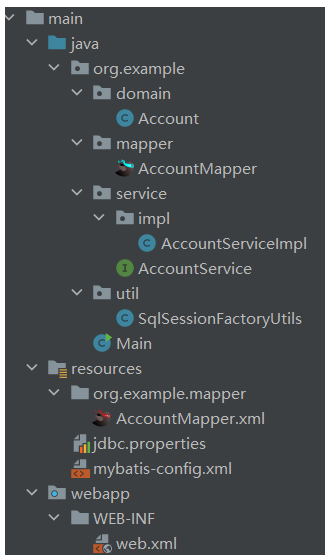
- 创建javaweb项目,在pom.xml添加
<packaging>war</packaging> - 配置pom.xml依赖和插件
<dependencies><!-- mysql --><dependency><groupId>mysql</groupId><artifactId>mysql-connector-java</artifactId><version>5.1.46</version></dependency><!-- mybatis --><dependency><groupId>org.mybatis</groupId><artifactId>mybatis</artifactId><version>3.5.5</version></dependency></dependencies><build><plugins><!--Tomcat插件,非必要 --><plugin><groupId>org.apache.tomcat.maven</groupId><artifactId>tomcat7-maven-plugin</artifactId><version>2.2</version></plugin></plugins></build> - 编写mybatis-config.xml配置文件
<?xml version="1.0" encoding="UTF-8" ?><!DOCTYPEconfigurationPUBLIC"-//mybatis.org//DTD Config 3.0//EN""http://mybatis.org/dtd/mybatis-3-config.dtd"><configuration><propertiesresource="jdbc.properties"/><environmentsdefault="development"><environmentid="development"><transactionManagertype="JDBC"/><dataSourcetype="POOLED"><!--数据库连接信息--><propertyname="driver"value="${jdbc.driver}"/><propertyname="url"value="${jdbc.url}"/><propertyname="username"value="${jdbc.username}"/><propertyname="password"value="${jdbc.password}"/></dataSource></environment></environments><mappers><packagename="org.example.mapper"/></mappers></configuration>jdbc.propertiesjdbc.driver=com.mysql.jdbc.Driverjdbc.url=jdbc:mysql:///spring_db?useSSL=false&useServerPrepStmts=truejdbc.username=rootjdbc.password=123456 - 创建AcccountMapper.xml和AccontMapper接口 AccountMapper.xml
<?xml version="1.0" encoding="UTF-8" ?><!DOCTYPEmapperPUBLIC"-//mybatis.org//DTD Mapper 3.0//EN""http://mybatis.org/dtd/mybatis-3-mapper.dtd"><mappernamespace="org.example.mapper.AccountMapper"></mapper>AccontMapper接口packageorg.example.mapper;publicinterfaceAccountMapper{@Insert("insert into tbl_account(name,money)values(#{name},#{money})")voidsave(Account account);@Delete("delete from tbl_account where id = #{id} ")voiddelete(Integer id);@Update("update tbl_account set name = #{name} , money = #{money} where id = #{id} ")voidupdate(Account account);@Select("select * from tbl_account")List<Account>findAll();@Select("select * from tbl_account where id = #{id} ")AccountfindById(Integer id);}在这一部分定义sql语句 - 编写service方法负责业务逻辑层,主要是调用数据库 准备工具类:SqlSessionFactoryUtils
packageorg.example.util;publicclassSqlSessionFactoryUtils{privatestaticSqlSessionFactory sqlSessionFactory;static{try{String resource ="mybatis-config.xml";InputStream inputStream =Resources.getResourceAsStream(resource); sqlSessionFactory =newSqlSessionFactoryBuilder().build(inputStream);}catch(IOException e){ e.printStackTrace();}}publicstaticSqlSessionFactorygetSqlSessionFactory(){return sqlSessionFactory;}}编写AccountService接口publicinterfaceAccountService{List<Account>findAll();}AccountService.javapackageorg.example.service.impl;publicclassAccountServiceImplimplementsAccountService{privateSqlSessionFactory factory =SqlSessionFactoryUtils.getSqlSessionFactory();@OverridepublicList<Account>findAll(){SqlSession session = factory.openSession();AccountMapper mapper = session.getMapper(AccountMapper.class);List<Account> accounts = mapper.findAll(); session.close();return accounts;}} - 接下来应该是在servlet类里面调用service方法,这里写在main函数里面
packageorg.example;publicclassMain{publicstaticvoidmain(String[] args){AccountService service =newAccountServiceImpl();List<Account> accounts = service.findAll();System.out.println(accounts);}}
即可成功获取到数据库数据
当Spring需要整合mybatis时,真正需要交给Spring管理的是
SqlSessionFactory
2.2 整合:导入依赖:pom.xml
<dependencies><!-- spring-context --><dependency><groupId>org.springframework</groupId><artifactId>spring-context</artifactId><version>5.2.10.RELEASE</version></dependency><!-- druid --><dependency><groupId>com.alibaba</groupId><artifactId>druid</artifactId><version>1.1.16</version></dependency><!-- mybatis --><dependency><groupId>org.mybatis</groupId><artifactId>mybatis</artifactId><version>3.5.5</version></dependency><!-- mysql --><dependency><groupId>mysql</groupId><artifactId>mysql-connector-java</artifactId><version>5.1.46</version></dependency><!-- spring-jdbc --><dependency><groupId>org.springframework</groupId><artifactId>spring-jdbc</artifactId><version>5.2.10.RELEASE</version></dependency><!-- mybatis-spring --><dependency><groupId>org.mybatis</groupId><artifactId>mybatis-spring</artifactId><version>1.3.0</version></dependency></dependencies>
2.3 整合:环境准备
步骤1:准备数据库表
create database spring_db character set utf8;
use spring_db;
create table tbl_account(
id int primary key auto_increment,
name varchar(35),
money double
);
insert into tbl_account values (null, 'zhangsan', 1999.10);
insert into tbl_account values (null, '张三', 32.43);
步骤2:创建基础文件
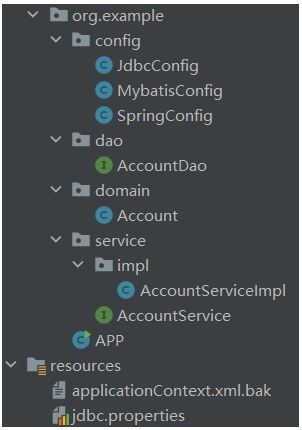
Account.java
packageorg.example.domain;publicclassAccount{privateInteger id;privateString name;privateDouble money;}//省略getter, setter, toString
AccountDao接口
这里的AccountDao就是AccountMapper的作用,需要加上注解
packageorg.example.dao;@Repository("accountDao")publicinterfaceAccountDao{@Insert("insert into tbl_account(name,money)values(#{name},#{money})")voidsave(Account account);@Delete("delete from tbl_account where id = #{id} ")voiddelete(Integer id);@Update("update tbl_account set name = #{name} , money = #{money} where id = #{id} ")voidupdate(Account account);@Select("select * from tbl_account")List<Account>findAll();@Select("select * from tbl_account where id = #{id} ")AccountfindById(Integer id);}
Service接口和实现类
接口是没有变化的
packageorg.example.service;publicinterfaceAccountService{voidsave(Account account);voiddelete(Integer id);voidupdate(Account account);List<Account>findAll();AccountfindById(Integer id);}
实现类变化很大,和之前相比,spring会接管SqlSessionFactory对象的创建,因此这次不需要创建了
重点:@Service和自动注入
packageorg.example.service.impl;@ServicepublicclassAccountServiceImplimplementsAccountService{@Autowired//自动注入@Qualifier("accountDao")privateAccountDao accountDao;publicvoidsave(Account account){
accountDao.save(account);}publicvoidupdate(Account account){
accountDao.update(account);}publicvoiddelete(Integer id){
accountDao.delete(id);}publicAccountfindById(Integer id){return accountDao.findById(id);}publicList<Account>findAll(){return accountDao.findAll();}}
jdbc.properties
resources目录下添加,用于配置数据库连接四要素
jdbc.driver=com.mysql.jdbc.Driver
jdbc.url=jdbc:mysql://localhost:3306/spring_db?useSSL=false
jdbc.username=root
jdbc.password=123456
useSSL:关闭MySQL的SSL连接
2.4 整合:Spring核心配置文件
在没有整合之前,mybatis的service类里面会创建SqlSessionFactory对象,来与数据库互通
在整合后,可以看到新的service类里面不再具备这样的功能
spring核心配置文件就是用来设置配置信息的,用以替代mybatis-config.xml等配置文件 ,并管理bean之间的依赖关系
SpringConfig.java
主配置类,推荐在这个配置类里面import其他配置类
packageorg.example.config;@Configuration//说明这是一个配置类@ComponentScan("org.example")//定义扫描路径@PropertySource("classpath:jdbc.properties")//引入连接信息资源文件@Import({JdbcConfig.class,MybatisConfig.class})//要么这里导入,要么在 JdbcConfig 前面加 @ConfigurationpublicclassSpringConfig{}
JdbcConfig.java
packageorg.example.config;//定义数据源 //本来是需要引入jdbc.properties的,但这里选择将所有文件都放在SpringConfig里面引入publicclassJdbcConfig{@Value("${jdbc.driver}")//自动注入privateString driver;@Value("${jdbc.url}")privateString url;@Value("${jdbc.username}")privateString username;@Value("${jdbc.password}")privateString password;@BeanpublicDataSourcedataSource(BookDao bookDao){DruidDataSource ds =newDruidDataSource();
ds.setDriverClassName(driver);
ds.setUrl(url);
ds.setUsername(username);
ds.setPassword(password);return ds;}}
MybatisConfig.java
SqlSessionFactoryBean
来源于
org.mybatis.spring
,可以直接获取SqlSessionFactory
packageorg.example.config;importorg.mybatis.spring.SqlSessionFactoryBean;importorg.mybatis.spring.mapper.MapperScannerConfigurer;importorg.springframework.context.annotation.Bean;importjavax.sql.DataSource;publicclassMybatisConfig{//sqlSessionFactoryBean完成了mybatis-config里面的<environment>部分@BeanpublicSqlSessionFactoryBeansqlSessionFactory(DataSource dataSource){//dataSource也是一个Bean,所以这里能够自动注入SqlSessionFactoryBean ssfb =newSqlSessionFactoryBean();
ssfb.setTypeAliasesPackage("org.example.domain");//取别名,domain是实体类包,相当于之前的pojo包
ssfb.setDataSource(dataSource);//设置数据源,即连接相关信息return ssfb;}//mapperScannerConfigurer完成了mybatis-config里面的<mappers>部分@BeanpublicMapperScannerConfigurermapperScannerConfigurer(){MapperScannerConfigurer msc =newMapperScannerConfigurer();
msc.setBasePackage("org.example.dao");//这里的dao包实际上就是之前学mybatis里面的mapper包return msc;}}
2.5 运行和说明
App.java
packageorg.example;publicclassApp{publicstaticvoidmain(String[] args){ApplicationContext ctx =newAnnotationConfigApplicationContext(SpringConfig.class);AccountService accountService = ctx.getBean(AccountService.class);//@Service标注会自动生成beanAccount account = accountService.findById(1);//即使后面AccountServiceImpl修改,也不影响这里的代码System.out.println(account);}}
说明
- 运行流程
- 程序启动时候检测使用了@Configuration注解的配置类SpringConfig- SpringConfig中引入了MybatisConfig和JdbcConfig,相当于这三个文件都成为一个配置文件- MybatisConfig通过JdbcConfig获取到了dataSource,里面带有配置数据库连接的信息,从而成功创建 SqlSessionFactory- 由于AccountServiceImpl.java上使用了注解@Service,且配置类SpringConfig定义了扫描路径"org.example",于是它将被纳入bean管理- 执行ctx.getBean(AccountService.class),这里实际上是以接口类去接实现类,类似于Father father = new Son();- 调用实现类的findById方法 - 关于Spring注入的是接口还是实现类? 参考:https://blog.csdn.net/m0_51697147/article/details/126802648- 在配置文件模式中,配置bean
<beanid="bookService"class="org.example.service.BookServiceImpl"><propertyname="bookDao"ref="bookDao"/></bean>获取beanBookService bookService = ctx.getBean(BookService.class);- 在注解开发模式中,配置bean@ServicepublicclassAccountServiceImplimplementsAccountService{@Autowired@Qualifier("accountDao")privateAccountDao accountDao;...}获取beanAccountService accountService = ctx.getBean(AccountService.class);从spring容器中获取一个类,如果这个类实现了一个接口并且该类存在一个AOP的切入点方法,那么通过getBean()获取到的bean类型只能是这个类的接口类型,不能是具体实现getBean()必须面向接口,这是因为底层实现用了代理,并由Proxy的内部实现决定优点:如果之后实现类发生改变,例如修改为AccountServiceImpl2.java,那么App.java里面的内容不必修改思考:如果有多个实现类继承了AccountService,这也写将会报错,那么如何处理?
3. Spring整合JUnit
1.导入依赖
<!-- junit --><dependency><groupId>junit</groupId><artifactId>junit</artifactId><version>4.12</version><scope>test</scope></dependency><!-- spring test --><dependency><groupId>org.springframework</groupId><artifactId>spring-test</artifactId><version>5.2.10.RELEASE</version></dependency>
2.编写测试类
packageorg.example.service;@RunWith(SpringJUnit4ClassRunner.class)//设定类运行器@ContextConfiguration(classes =SpringConfig.class)//加载配置类//@ContextConfiguration(locations={"classpath:applicationContext.xml"})//加载配置文件publicclassAccountServiceTest{//支持自动装配注入bean@AutowiredprivateAccountService accountService;@TestpublicvoidtestFindById(){System.out.println(accountService.findById(2));}@TestpublicvoidtestFindAll(){System.out.println(accountService.findAll());}}
要测试哪个方法,就在哪个方法那里点击执行
- 单元测试,如果测试的是注解配置类,则使用
@ContextConfiguration(classes = 配置类.class) - 单元测试,如果测试的是配置文件,则使用
@ContextConfiguration(locations={配置文件名,...}) - Junit运行后是基于Spring环境运行的,所以Spring提供了一个专用的类运行器,这个务必要设置,这个类运行器就在Spring的测试专用包中提供的,导入的坐标就是这个东西
SpringJUnit4ClassRunner - 上面两个配置都是固定格式,当需要测试哪个bean时,使用自动装配加载对应的对象
知识点1:@RunWith
名称@RunWith类型测试类注解位置测试类定义上方作用设置JUnit运行器属性value(默认):运行所使用的运行期
知识点2:@ContextConfiguration
名称@ContextConfiguration类型测试类注解位置测试类定义上方作用设置JUnit加载的Spring核心配置属性classes:核心配置类,可以使用数组的格式设定加载多个配置类
locations:配置文件,可以使用数组的格式设定加载多个配置文件名称
4. AOP
AOP
(Aspect Oriented Programming)面向切面编程,一种编程范式,指导开发者如何组织程序结构
OOP
(Object Oriented Programming)面向对象编程
Spring有两个核心的概念,一个是
IOC/DI
,一个是
AOP
作用:AOP是在不改原有代码的前提下对其进行增强
Spring理念:无入侵时/无侵入式
4.1 AOP核心概念
packageorg.example.dao.impl;importorg.example.dao.BookDao;importorg.springframework.stereotype.Repository;@RepositorypublicclassBookDaoImplimplementsBookDao{publicvoidsave(){//记录程序当前执行执行(开始时间)Long startTime =System.currentTimeMillis();//业务执行万次for(int i =0;i<10000;i++){System.out.println("book Dao");}//记录程序当前执行时间(结束时间)Long endTime =System.currentTimeMillis();//计算时间差Long totalTime = endTime-startTime;//输出信息System.out.println("执行万次消耗时间:"+ totalTime +"ms");}publicvoidupdate(){System.out.println("book dao update ...");}publicvoiddelete(){System.out.println("book dao delete ...");}publicvoidselect(){System.out.println("book dao select ...");}}
需求:希望对update、delete函数执行和save一样的流程,即执行10000次,然后打印时间差
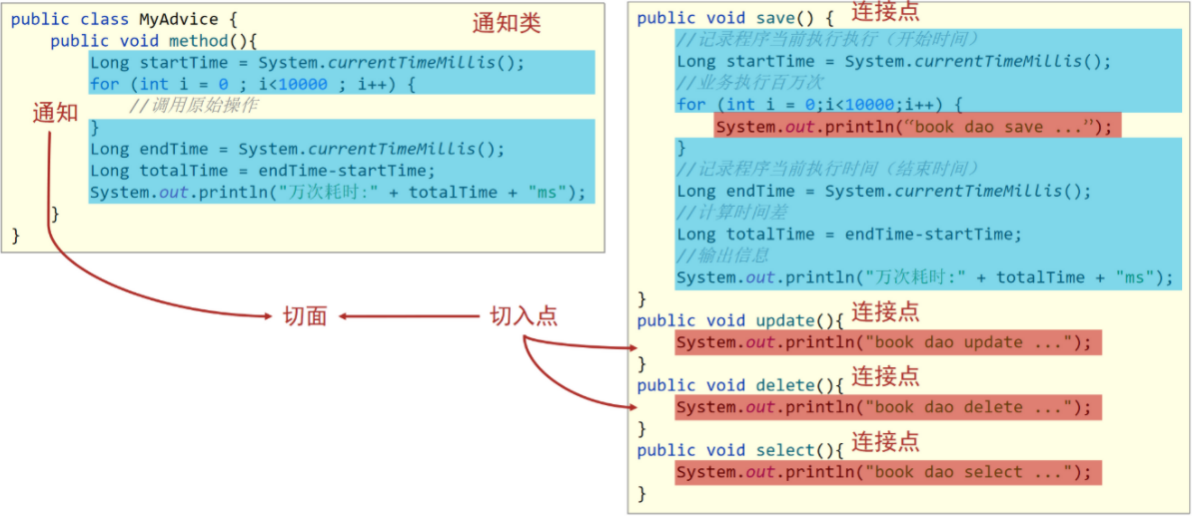
AOP中的核心概念
- 连接点(JoinPoint):程序执行过程中的任意位置,粒度为执行方法、抛出异常、设置变量等- 在SpringAOP中,理解为方法的执行- AOP将每一个方法调用,即连接点作为编程的入口,针对方法调用进行编程
- **切入点(Pointcut)**:匹配连接点的式子- 指需要被增强的方法- 切入点是连接点,但连接点不一定是切入点
- **通知(Advice)**:在切入点处执行的操作,也就是共性功能- 如上面的计算万次执行消耗时间作为共性功能,被抽取到一个方法中,这个方法就是通知- 在SpringAOP中,功能最终以方法的形式呈现
- 通知类:定义通知的类
- **切面(Aspect)**:描述通知与切入点的对应关系。- 通知是要增强的内容,会有多个,切入点是需要被增强的方法,也会有多个,通知与切入点的对应关系叫切面
4.2 AOP入门案例
需求:在方法执行前输出当前系统时间。
开发模式:XML 和 注解
步骤:
- 导入坐标(pom.xml)
<!-- spring-context里面包含了aop --><dependency><groupId>org.springframework</groupId><artifactId>spring-context</artifactId><version>5.2.10.RELEASE</version></dependency><!-- aspectjweaver --><dependency><groupId>org.aspectj</groupId><artifactId>aspectjweaver</artifactId><version>1.9.4</version></dependency> - 制作连接点(原始操作,Dao接口与实现类)
packageorg.example.dao;publicinterfaceBookDao{publicvoidsave();publicvoidupdate();}``````packageorg.example.dao.impl;@RepositorypublicclassBookDaoImplimplementsBookDao{publicvoidsave(){System.out.println(System.currentTimeMillis());System.out.println("book dao save ...");}publicvoidupdate(){System.out.println("book dao update ...");}} - **制作共性功能(通知类与通知)**新建包aop,新建MyAdvice通知类,printTime即为通知方法
- 定义切入点切入点即 pt() ,需要注解
@Pointcut注明哪些方法需要被增强 - 绑定切入点与通知关系(切面)
@Before说明切入点与通知的关系 - 配置Spring环境
packageorg.example.aop;//6. 配置Spring环境@Component//需要将其交给Spring管理@Aspect//告诉Spring当作AOP处理,而非BeanpublicclassMyAdvice{//4. 定义切入点@Pointcut("execution(void org.example.dao.BookDao.update())")privatevoidpt(){}//5. 绑定切入点与通知关系(切面)@Before("pt()")//在pt()方法前执行//3. 制作共性功能(通知类与通知)publicvoidprintTime(){System.out.println(System.currentTimeMillis());}}``````packageorg.example.config;@Configuration@ComponentScan("org.example")@EnableAspectJAutoProxy//开启Spring对AOP注解驱动支持publicclassSpringConfig{} - 运行
ApplicationContext ctx =newAnnotationConfigApplicationContext(SpringConfig.class);BookDao bookDao = ctx.getBean(BookDao.class);bookDao.update();
@EnableAspectJAutoProxy @Aspect @Pointcut @Before
名称@EnableAspectJAutoProxy类型配置类注解位置配置类定义上方作用开启注解格式AOP功能名称@Aspect类型类注解位置切面类定义上方作用设置当前类为AOP切面类名称@Pointcut类型方法注解位置切入点方法定义上方作用设置切入点方法属性value(默认):切入点表达式名称@Before类型方法注解位置通知方法定义上方作用设置当前通知方法与切入点之间的绑定关系,当前通知方法在原始切入点方法前运行
4.3 AOP原理
AOP工作流程
由于AOP是基于Spring容器管理的bean做的增强,所以整个工作过程需要从Spring加载bean说起
工作流程
- 流程1:Spring容器启动容器启动就需要去加载bean,带有@Component,@Service ,@Controller 的类都是spring 要创建的bean对象- 需要被增强的类BookDaoImpl,通知类MyAdvice- 注意此时bean对象还没有创建成功
- 流程2:读取所有切面配置中的切入点
@Component@AspectpublicclassMyAdvice{@Pointcut("execution(void org.example.dao.BookDao.save())")privatevoidptx(){}@Pointcut("execution(void org.example.dao.BookDao.update())")privatevoidpt(){}@Before("pt()")publicvoidprintTime(){System.out.println(System.currentTimeMillis());}}有两个切入点,其中切入点ptx()并没有被使用,所以不会被读取 - 流程3:初始化bean在容器启动的时候,bean对象还没有被创建成功 在创建bean对象时,需要判定bean对应的类中的方法是否匹配到任意切入点,以BookDao为例- 匹配失败,创建原始对象,即BookDao本身的对象 - 匹配失败,即该类中没有一个方法能匹配上切入点,说明不需要增强,直接调用原始对象的方法即可- 匹配成功,创建原始对象(
目标对象)的代理对象- 匹配成功说明需要对其进行增强- 对哪个类做增强,这个类对应的对象就叫做目标对象- 因为要对目标对象进行功能增强,而采用的技术是动态代理,所以会为其创建一个代理对象- 最终运行的是代理对象的方法,在该方法中会对原始方法进行功能增强 - 流程4:获取bean并执行方法- 获取的bean是原始对象时,调用方法并执行,完成操作- 获取的bean是代理对象时,根据代理对象的运行模式运行原始方法与增强的内容,完成操作
验证代理
System.out.println(bookDao);System.out.println(bookDao.getClass());

打印bookDao时,由于代理里面重写了toString,所以看到的是BookDaoImpl
打印Class就可以看到,最终生成的是目标对象的代理对象
AOP核心概念 - 代理
- **目标对象(Target)**:原始功能去掉共性功能对应的类产生的对象,这种对象是无法直接完成最终工作的
- **代理(Proxy)**:目标对象无法直接完成工作,需要对其进行功能回填,通过原始对象的代理对象实现
SpringAOP是在不改变原有设计(代码)的前提下对其进行增强的,它的底层采用的是代理模式实现的,所以要对原始对象进行增强,就需要对原始对象创建代理对象,在代理对象中的方法把通知[如:MyAdvice中的method方法]内容加进去,就实现了增强,这就是我们所说的代理(Proxy)。
SpringAOP的本质或者可以说底层实现是通过代理模式
4.4 AOP切入点表达式
切入点:要进行增强的方法
切入点表达式:要进行增强的方法的描述方式
- 接口描述
execution(voidorg.example.dao.BookDao.update()) - 实现类描述
execution(voidorg.example.dao.impl.BookDaoImpl.update())
因为调用接口方法的时候最终运行的还是其实现类的方法,所以上面两种描述方式都是可以的
切入点表达式标准格式
动作关键字(访问修饰符 返回值 包名.类/接口名.方法名(参数) 异常名)
execution(publicUserorg.example.service.UserService.findById(int))
切入点通配符
*:单个独立的任意符号,可以独立出现,也可以作为前缀或者后缀的匹配符出现execution(public * org.example.*.UserService.find*(*))匹配org.example包下的任意包中的UserService类或接口中所有find开头的带有一个参数的方法..:多个连续的任意符号,可以独立出现,常用于简化包名与参数的书写execution(public User org..UserService.findById(..))匹配org包下的任意包中的UserService类或接口中所有名称为findById的方法+:专用于匹配子类类型execution(* *..*Service+.*(..))很少使用。*Service+,表示所有以Service结尾的接口的子类。
切入点表达式练习
//匹配接口,能匹配到execution(voidorg.example.dao.BookDao.update())//匹配实现类,能匹配到execution(voidorg.example.dao.impl.BookDaoImpl.update())//返回值任意,能匹配到execution(*org.example.dao.impl.BookDaoImpl.update())//返回值任意,但是update方法必须要有一个参数,无法匹配,要想匹配需要在update接口和实现类添加参数execution(*org.example.dao.impl.BookDaoImpl.update(*))//返回值为void,org包下的任意包三层包下的任意类的update方法,匹配到的是实现类,能匹配execution(void org.*.*.*.*.update())//返回值为void,org包下的任意两层包下的任意类的update方法,匹配到的是接口,能匹配execution(void org.*.*.*.update())//返回值为void,方法名是update的任意包下的任意类,能匹配execution(void*..update())//匹配项目中任意类的任意方法,能匹配,但是不建议使用这种方式,影响范围广execution(**..*(..))//匹配项目中任意包任意类下只要以u开头的方法,update方法能满足,能匹配execution(**..u*(..))//匹配项目中任意包任意类下只要以e结尾的方法,update和save方法能满足,能匹配execution(**..*e(..))//返回值为void,org包下的任意包任意类任意方法,能匹配,*代表的是方法(这个代表方法的*不能省略)execution(void org..*())//将项目中所有业务层方法的以find开头的方法匹配execution(* org.example.*.*Service.find*(..))//将项目中所有业务层方法的以save开头的方法匹配execution(* org.example.*.*Service.save*(..))
书写技巧
- 所有代码按照标准规范开发
- 描述切入点
通常描述接口,而不描述实现类,如果描述到实现类,就出现紧耦合了 - 访问控制修饰符针对
接口开发均采用public描述(可省略访问控制修饰符描述) - 返回值类型对于
增删改类使用精准类型加速匹配,对于查询类使用*通配快速描述 包名书写尽量不使用..匹配,效率过低,常用*做单个包描述匹配,或精准匹配接口名/类名书写名称与模块相关的采用*匹配,例如UserService书写成*Service,绑定业务层接口名方法名书写以动词进行精准匹配,名词采用*匹配,例如getById书写成getBy*,selectAll书写成selectAll- 参数规则较为复杂,根据业务方法灵活调整
- 通常
不使用异常作为匹配规则
4.5 AOP通知类型
5种通知类型
- 前置通知
@Before("pt()") - 后置通知
@After("pt()") - 环绕通知(重点)
packageorg.example.aop;@Component@AspectpublicclassMyAdvice{@Pointcut("execution(void org.example.dao.BookDao.update())")privatevoidpt(){}@Around("pt()")publicvoidaroundSelect(ProceedingJoinPoint pjp)throwsThrowable{//前置System.out.println("before advice");//原始操作 pjp.proceed();//后置System.out.println("after advice");}}有返回值的情况packageorg.example.aop;@Component@AspectpublicclassMyAdvice{@Pointcut("execution(int org.example.dao.BookDao.select())")privatevoidpt(){}@Around("pt()")publicObjectaroundUpdate(ProceedingJoinPoint pjp)throwsThrowable{//前置System.out.println("before advice");//原始操作Object ret = pjp.proceed();//后置System.out.println("after advice");return ret;}} - 返回后通知(了解)
@AfterReturning("pt()")返回后通知是需要在原始方法select正常执行后才会被执行,如果过程中出现了异常,那么返回后通知是不会被执行 后置通知是不管原始方法有没有抛出异常都会被执行 - 抛出异常后通知(了解)
@AfterThrowing("pt()")如果有异常才会执行
注意事项
- 环绕通知必须依赖形参
ProceedingJoinPoint才能实现对原始方法的调用 - 对原始方法的调用可以不接收返回值,通知方法设置成void即可,如果接收
返回值,最好设定为Object类型 - 由于无法预知原始方法运行后是否会抛出异常,因此环绕通知方法必须要处理
Throwable异常
4.6 案例:业务层接口执行效率
需求:任意业务层接口执行均可显示其执行效率(执行时长)
环境准备:使用前面整合MyBatis和Junit之后的项目
- 添加pom.xml依赖
<!-- spring-context --><dependency><groupId>org.springframework</groupId><artifactId>spring-context</artifactId><version>5.2.10.RELEASE</version></dependency><!-- aspectjweaver --><dependency><groupId>org.aspectj</groupId><artifactId>aspectjweaver</artifactId><version>1.9.4</version></dependency> - 配置SpringConfig环境
packageorg.example.config;@Configuration@ComponentScan("org.example")@PropertySource("classpath:jdbc.properties")@Import({JdbcConfig.class,MybatisConfig.class})@EnableAspectJAutoProxypublicclassSpringConfig{} - 创建通知类 org.example.aop.ProjectAdvice
- 编写通知方法
packageorg.example.aop;@Component@AspectpublicclassProjectAdvice{//1. 切入点:匹配业务层的所有方法@Pointcut("execution(* org.example.service.*Service.*(..))")privatevoidservicePt(){}//2. 环绕方法@Around("ProjectAdvice.servicePt()")publicvoidrunSpeed(ProceedingJoinPoint pjp)throwsThrowable{//ProceedingJoinPoint:连接点,携带原始方法信息Signature signature = pjp.getSignature();String className = signature.getDeclaringTypeName();String methodName = signature.getName();//前置:获取开始时间long start =System.currentTimeMillis();for(int i=0; i<10000;++i){//调用原始方法Object ret = pjp.proceed();}//后置:获取结束时间long end =System.currentTimeMillis();System.out.println("万次执行:"+className+"."+methodName+" 时间为:"+(end-start)+"ms");}} - 测试类
packageorg.example.service;@RunWith(SpringJUnit4ClassRunner.class)//设定类运行器@ContextConfiguration(classes =SpringConfig.class)publicclassAccountServiceTest{@AutowiredprivateAccountService accountService;@TestpublicvoidtestFindById(){ accountService.findById(2);}@TestpublicvoidtestFindAll(){ accountService.findAll();}}
4.7 AOP通知获取数据
- 获取切入点方法的
参数,所有的通知类型都可以获取参数 - JoinPoint:适用于前置、后置、返回后、抛出异常后通知- ProceedingJoinPoint:适用于环绕通知 - 获取切入点方法
返回值,前置和抛出异常后通知是没有返回值,后置通知可有可无,所以不做研究 - 返回后通知- 环绕通知 - 获取切入点方法运行
异常信息,前置和返回后通知是不会有,后置通知可有可无,所以不做研究 - 抛出异常后通知- 环绕通知
获取参数
packageorg.example.aop;@Component@AspectpublicclassMyAdvice{@Pointcut("execution(* org.example.dao.BookDao.findName(..))")privatevoidpt(){}@Before("pt()")publicvoidbefore(JoinPoint jp){Object[] args = jp.getArgs();}@After("pt()")publicvoidafter(JoinPoint jp){Object[] args = jp.getArgs();}@Around("pt()")publicObjectaround(ProceedingJoinPoint pjp)throwsThrowable{Object[] args = pjp.getArgs();
args[0]=666;//可以中途修改参数Object ret = pjp.proceed(args);return ret;}}
环绕方法可以修改传递过来的参数,有时可以用作对参数清洗
返回值
@AfterReturning(value ="pt()", returning ="ret")publicvoidafterReturning(JoinPoint jp,Object ret){//注意如果有JoinPoint参数,它必须得在第一位System.out.println("afterReturning advice ..."+ret);//ret即为返回值}
获取异常
@AfterThrowing(value ="pt()", throwing ="t")publicvoidafterThrowing(Throwable t){System.out.println("afterThrowing advice .."+t);}
5. AOP事务管理
5.1 Spring事务简介
- 事务作用:在数据层保障一系列的数据库操作同成功同失败
- Spring事务作用:在数据层或业务层保障一系列的数据库操作同成功同失败
Spring为了管理事务,提供了一个平台事务管理器
PlatformTransactionManager

commit
是用来提交事务,
rollback
是用来回滚事务
PlatformTransactionManager只是一个接口,Spring还为其提供了一个具体的实现
只需要给它一个DataSource对象,它就可以帮你去在业务层管理事务。其内部采用的是JDBC的事务
所以如果你持久层采用的是JDBC相关的技术,就可以采用这个事务管理器来管理事务。而Mybatis内部采用的就是JDBC的事务,所以后期Spring整合Mybatis就采用的这个DataSourceTransactionManager事务管理器。
5.2 Spring事务案例
无事务管理情况
需求: 实现任意两个账户间转账操作,A账户减钱和B账户加钱必须是同成功或同失败
准备工作:第2节中整合MyBatis中的spring-mybatis项目
步骤1:准备数据库表
含有 id name money 三个属性的数据库表
步骤2:创建项目导入jar包
步骤3:根据表创建模型类
即Account类
步骤4:创建Dao接口
在AccountDao.java中加入
@Update("update tbl_account set money = money + #{money} where name = #{name}")voidinMoney(@Param("name")String name,@Param("money")Double money);@Update("update tbl_account set money = money - #{money} where name = #{name}")voidoutMoney(@Param("name")String name,@Param("money")Double money);
步骤5:编写Service接口和实现类
packageorg.example.service;publicinterfaceAccountService{/**
* 转账
* @param out:转出账户
* @param in:转入账户
* @param money:转账金额
*/publicvoidtransfer(String out,String in,Double money);}
packageorg.example.service.impl;@ServicepublicclassAccountServiceImplimplementsAccountService{//自动注入accountDao@Autowired@Qualifier("accountDao")privateAccountDao accountDao;@Overridepublicvoidtransfer(String out,String in,Double money){
accountDao.outMoney(out, money);
accountDao.inMoney(in, money);}}
步骤6:编写配置类
SpringConfig,JdbcConfig,MybatisConfig,jdbc.properties
步骤7:编写测试类
packageorg.example.service;@RunWith(SpringJUnit4ClassRunner.class)@ContextConfiguration(classes =SpringConfig.class)publicclassAccountServiceTest{@AutowiredprivateAccountService accountService;@TestpublicvoidtestTransfer()throwsIOException{
accountService.transfer("zhangsan","lisi",100D);}}
问题
当增加和修改两个操作中间出现异常时,会出现一个账户减少了,而另一个账户却没增加的错误!,如:
publicvoidtransfer(String out,String in,Double money){
accountDao.outMoney(out, money);int i =1/0;
accountDao.inMoney(in, money);}
开启事务处理
步骤1:添加@Transactional注解
可以写在接口类上、接口方法上、实现类上和实现类方法上
- 写在接口类上,该接口的所有实现类的所有方法都会有事务
- 写在接口方法上,该接口的所有实现类的该方法都会有事务
- 写在实现类上,该类中的所有方法都会有事务
- 写在实现类方法上,该方法上有事务
- 常写在方法前
packageorg.example.service;publicinterfaceAccountService{@Transactionalpublicvoidtransfer(String out,String in,Double money);}
步骤2:在JdbcConfig类中配置事务管理器
packageorg.example.config;publicclassJdbcConfig{@Value("${jdbc.driver}")//自动注入privateString driver;@Value("${jdbc.url}")privateString url;@Value("${jdbc.username}")privateString username;@Value("${jdbc.password}")privateString password;@BeanpublicDataSourcedataSource(){DruidDataSource ds =newDruidDataSource();
ds.setDriverClassName(driver);
ds.setUrl(url);
ds.setUsername(username);
ds.setPassword(password);return ds;}@BeanpublicPlatformTransactionManagertransactionManager(DataSource dataSource){//自动注入dataSourceDataSourceTransactionManager transactionManager =newDataSourceTransactionManager();
transactionManager.setDataSource(dataSource);return transactionManager;}}
事务管理器要根据使用技术进行选择,Mybatis框架使用的是JDBC事务,可以直接使用
DataSourceTransactionManager
步骤3:在SpringConfig中开启事务注解
packageorg.example.config;importorg.springframework.context.annotation.*;importorg.springframework.transaction.annotation.EnableTransactionManagement;@Configuration@ComponentScan("org.example")@PropertySource("classpath:jdbc.properties")@Import({JdbcConfig.class,MybatisConfig.class})//开启注解式事务驱动@EnableTransactionManagementpublicclassSpringConfig{}
至此即可实现transfer函数的同成功或同失败
5.3 Spring事务角色
- 事务管理员:发起事务方,在Spring中通常指代业务层开启事务的方法,如
transfer() - 事务协调员:加入事务方,在Spring中通常指代数据层方法,也可以是业务层方法,如
outMoney()和inMoney
- 未开启Spring事务之前
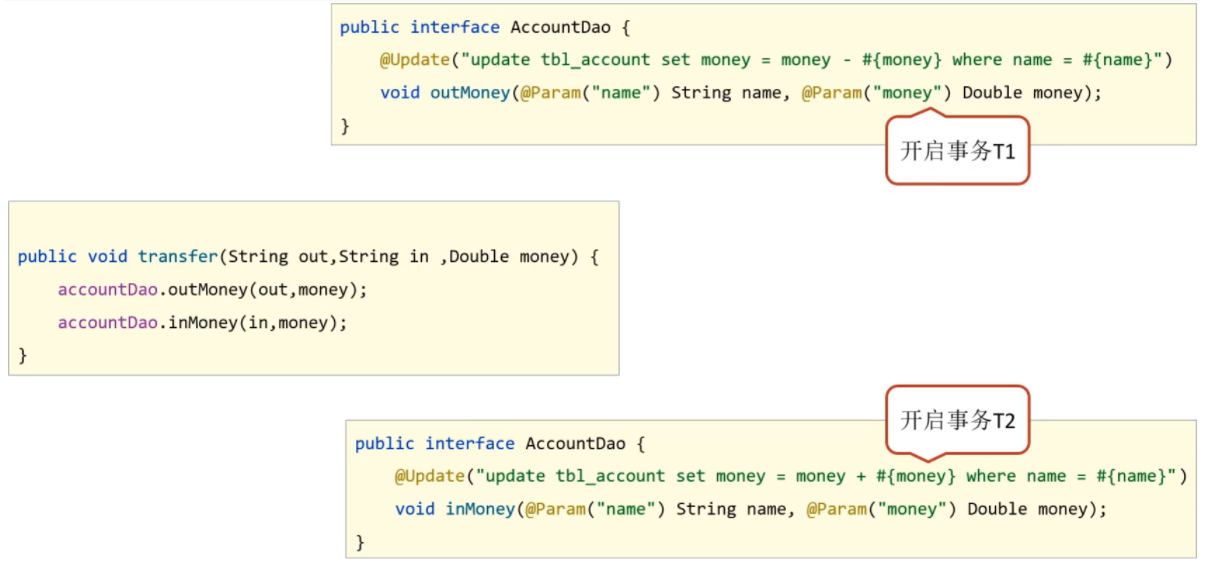
- AccountDao的outMoney因为是修改操作,会开启一个事务T1
- AccountDao的inMoney因为是修改操作,会开启一个事务T2
- AccountService的transfer没有事务, - 运行过程中如果没有抛出异常,则T1和T2都正常提交,数据正确- 如果在两个方法中间抛出异常,T1因为执行成功提交事务,T2因为抛异常不会被执行- 就会导致数据出现错误
- 开启Spring的事务管理后

- transfer上添加了@Transactional注解,在该方法上就会有一个事务T
- AccountDao的outMoney方法的事务T1加入到transfer的事务T中
- AccountDao的inMoney方法的事务T2加入到transfer的事务T中
- 这样就保证他们在同一个事务中,当业务层中出现异常,整个事务就会回滚,保证数据的准确性。
目前的事务管理是基于
DataSourceTransactionManager
和
SqlSessionFactoryBean
使用的是同一个数据源
5.4 Spring事务属性
事务配置

@Transactional(readOnly =true, timeout =-1)
- rollbackFor(重点)当transfer()的代码如下时,先前的事务管理失效,仍然导致一方改变了,而另一方未改变
@Overridepublicvoidtransfer(String out,String in,Double money)throwsIOException{ accountDao.outMoney(out, money);if(true)thrownewIOException(); accountDao.inMoney(in, money);}原因:Spring的事务只会对Error异常和RuntimeException异常及其子类进行事务回滚,其他的异常类型是不会回滚的,对应IOException不符合上述条件所以不回滚修改:设置rollbackFor``````@Transactional(rollbackFor ={IOException.class})publicvoidtransfer(String out,String in,Double money)throwsIOException; - readOnly:true只读事务,false读写事务,增删改要设为false,查询设为true。
- timeout:设置超时时间单位秒,在多长时间之内事务没有提交成功就自动回滚,-1表示不设置超时时间。
- noRollbackFor:当出现指定异常不进行事务回滚
- rollbackForClassName:等同于rollbackFor,只不过属性为异常的类全名字符串
- noRollbackForClassName:等同于noRollbackFor,只不过属性为异常的类全名字符串
- isolation设置事务的隔离级别(见MySQL数据库相关知识)- DEFAULT:默认隔离级别, 会采用数据库的隔离级别- READ_UNCOMMITTED : 读未提交- READ_COMMITTED : 读已提交- REPEATABLE_READ : 重复读取- SERIALIZABLE: 串行化
案例:转账业务追加案例
需求:无论转账操作是否成功,均进行转账操作的日志留痕
准备工作:基于前面5.2节的案例
步骤1:添加数据库表
create table tbl_log(
id int primary key auto_increment,
info varchar(255),
createDate datetime
)
步骤2:添加LogDao接口
packageorg.example.dao;@RepositorypublicinterfaceLogDao{@Insert("insert into tbl_log (info, createDate) values (#{info}, now())")voidlog(String info);}
步骤3:添加LogService接口与实现类
packageorg.example.service;publicinterfaceLogService{@Transactionalpublicvoidlog(String out,String in,Double money);}
packageorg.example.service.impl;@ServicepublicclassLogServiceImplimplementsLogService{@AutowiredprivateLogDao logDao;@Overridepublicvoidlog(String out,String in,Double money){
logDao.log("转账操作由"+out+"到"+in+",金额:"+money);}}
步骤4:在转账的业务中添加记录日志
packageorg.example.service;publicinterfaceAccountService{@Transactionalpublicvoidtransfer(String out,String in,Double money);}
packageorg.example.service.impl;@ServicepublicclassAccountServiceImplimplementsAccountService{@Autowired@Qualifier("accountDao")privateAccountDao accountDao;@AutowiredprivateLogService logService;@Overridepublicvoidtransfer(String out,String in,Double money){try{
accountDao.outMoney(out, money);int i =1/0;
accountDao.inMoney(in, money);}finally{
logService.log(out, in, money);}}}
注意:结果如果报异常,记录不会被写入tbl_log表中去,
因为此时日志记录和转账操作隶属于一个事务,同成功同失败,那么转账被回滚了失败了,日志记录自然也失败了
但是需求是:无论转账是否成功,都记录日志
此时需要:转账的两个操作inMoney和outMoney加入到transfer事务中,但记录日志的log操作单独启动一个事务
事务传播行为
修改日志的事务属性:
propagation
packageorg.example.service;publicinterfaceLogService{@Transactional(propagation =Propagation.REQUIRES_NEW)//开启新事物publicvoidlog(String out,String in,Double money);}
packageorg.example.service.impl;@ServicepublicclassLogServiceImplimplementsLogService{@AutowiredprivateLogDao logDao;@Overridepublicvoidlog(String out,String in,Double money){
logDao.log("转账操作由"+out+"到"+in+",金额:"+money);}}
此时即可实现失败转账操作回滚,但日志仍被记录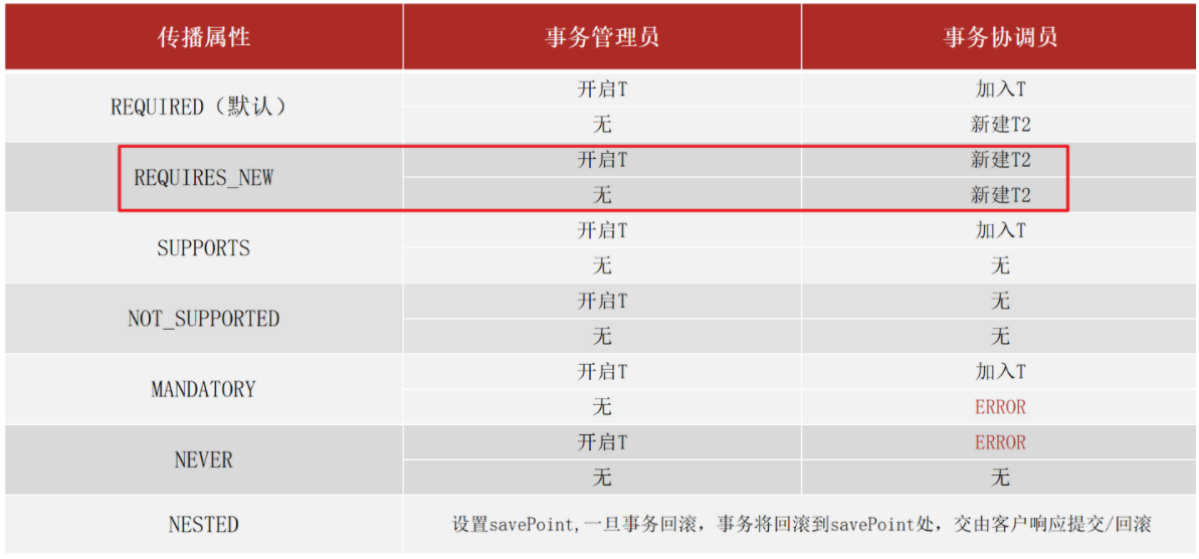
版权归原作者 wxygf 所有, 如有侵权,请联系我们删除。